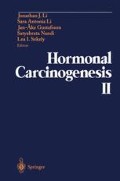Abstract
Tamoxifen is an anti-estrogen widely used with proven efficacy in the treatment of breast cancer in women (1). It is well tolerated and has potentially beneficial actions in reducing serum cholesterol (2) and the incidence of fatal heart attacks (3). Preliminary results suggest that tamoxifen will reduce the incidence of breast cancer in such women (2). However, several epidemiological studies in women with breast cancer have shown that tamoxifen can also lead to increased incidence of endometrial tumors (4–6). Although tamoxifen is primarily an antiestrogen, it also has some estrogenic properties. At present, it is not clear whether the effect on the endometrium is due to estrogen-like stimulation by tamoxifen, causing cell proliferation and the promotion of endogenous lesions, or a direct mutagenic effect on the affected cells.
Access this chapter
Tax calculation will be finalised at checkout
Purchases are for personal use only
Preview
Unable to display preview. Download preview PDF.
References
Cummings FJ, Gray R, Tormey DC, et al. (1993) Adjuvant tamoxifen versus placebo in elderly women with node-positive breast cancer: Long-term follow-up and causes of death. J Clin Oncol 11:29–35.
Powles TJ, Jones AL, Ashley SE, et al. (1994) The Royal Marsden Hospital pilot tamoxifen chemoprevention trial. Breast Cancer Res Treat 31:73–82.
McDonald CC, Stewart HJ (1991) Fatal myocardial infarction in the Scottish adjuvant tamoxifen trial. Brit Med J 303:435–437.
Marshall E (1994) Tamoxifen: Hanging in the balance. Science 264:1524–1527.
Jordan VC (1988) Tamoxifen and endometrial cancer. Lancet 2:1019
Fornander T, Rutqvist LE, Wilking N (1991) Effects of tamoxifen on the female genital tract. Ann N Y Acad Sei USA 622:469–473.
Tucker MJ, Adams HK, Patterson JS (1984) Tamoxifen. In Laurence DR, McLean AEM, Weatherall M (eds): Safety Testing of New Drugs. New York: Academic Press, pp 125–161.
Greaves P, Goonetilleke R, Nunn G, et al. (1993) Two-year carcinogenicity study of tamoxifen in Alderly Park Wistar-derived rats. Cancer Res 53:3919–3924.
Hard GC, Iatropoulos MJ, Jordan K, et al. (1993) Major differences in the hepatocarcinogenicity and DNA adduct forming ability between toremifene and tamoxifen in female Crl:CD(BR) rats. Cancer Res 53:4534–4541.
Hirsimaki P, Hirsimaki Y, Nieminen L, et al. (1993) Tamoxifen induces hepatocellular carcinoma in rat liver-A 1-year study with 2 antiestrogens. Arch Toxicol 67:49–54.
Jordan VC, Robinson SP (1987) Species-specific pharmacology of antiestrogens: Role of metabolism. Fed eration Proc 46:1870–1874.
White INH, De Matteis F, Davies A, et al. (1992) Genotoxic potential of tamoxifen and analogues in female Fischer F344/N rats, DBA/2 and C57B1/6 mice and in human MCL-5 cells. Carcinogenesis 13:2197–2203.
Dahme E, Rattel B (1994) Unlike tamoxifen, droloxifene produces no hepatic tumors in the rat. Onkologie 17:6–16.
Carthew P, Martin EA, White INH, et al. (1995) Tamoxifen induces short-term cumulative DNA damage and liver tumors in rats: Promotion by phenobarbital. Cancer Res 55:544–547.
Carthew P, Rich KJ, Martin EA, et al. (1995) DNA damage as assessed by 32P-postlabelling in three rat stains exposed to dietary tamoxifen: The relationship between cell proliferation and liver tumour formation. Carcinogenesis, in press.
Carthew P, Martin EA, White INH, et al. (1995) Tamoxifen induces short-term cumulative DNA damage and liver tumors in rats: Promotion by phenobarbital. Cancer Res 55:544–547.
White INH, Davies A, Smith LL, et al. (1993) Induction of CYP2B1 and 3A1, and associated monooxygenase activities by tamoxifen and certain analogues in the livers of female rats and mice. Biochem Pharmacol 45:21–30.
Lim CK, Yuan Z, Lamb JH, et al. (1994) A comparative study of tamoxifen metabolism in female rat, mouse and human liver microsomes. Carcinogenesis 15:589–593.
Martin EA, Rich K, White INH, et al. (1995)32P-Postlabelled DNA adducts in liver obtained from women treated with tamoxifen. Carcinogenesis, in press.
Fromson JM, Pearson S, Bramah S (1973) Metabolism of tamoxifen (ICI 46,474) Part II: In female patients. Xenobiotica 3:711–714.
Styles JA, Davies A, Lim CK, et al. (1994) Genotoxicity of tamoxifen, tamoxifen epoxide and toremifene in human lymphoblastoid cells containing human cytochrome P450s. Carcinogenesis 15:5–9.
Mani C, Kupfer D (1991) Cytochrome P450 mediated action and irreversible binding of the antiestrogen tamoxifen to proteins in rat and human liver: Possible involvement of the flavin-containing monooxygenases in tamoxifen activation. Cancer Res 51:6052–6058.
White INH, De Matteis F, Gibbs AH, et al. (1995) Species differences in the covalent binding of [14C]tamoxifen to liver microsomes and the forms of cytochrome P450 involved. Biochem Pharmacol, in press.
Pathak DN, Pongracz K, Bodell WJ (1995) Microsomal and peroxidase activation of 4-hydroxytamoxifen to form DNA adducts: Comparison with DNA adducts formed in Sprague-Dawley rats treated with tamoxifen. Carcinogenesis 16:11–15.
Davies AM, Martin EA, Jones RM, et al. (1995) Peroxidase activation of tamoxifen and toremifene to cause DNA damage and covalently bound protein adducts. Carcinogenesis 16:539–545.
Phillips DH, Hewer A, White INH, et al. (1994) Co-chromatography of a tamoxifen epoxide-deoxyguanylic acid adduct with a major DNA adduct formed in the livers of tamoxifen-treated rats. Carcinogenesis 15:793–795.
Phillips DH, Potter GA, Horton MN, et al. (1994) Reduced genotoxicity of [D5-ethyl]-tamoxifen implicates a-hydroxylation of the ethyl group as a major pathway of tamoxifen activation to a liver carcinogen. Carcinogenesis 15:1487–1492.
Editor information
Editors and Affiliations
Rights and permissions
Copyright information
© 1996 Springer-Verlag New York, Inc.
About this paper
Cite this paper
White, I.N.H., Smith, L.L. (1996). Mechanisms of Tamoxifen-Induced Genotoxicity and Carcinogenicity. In: Li, J.J., Li, S.A., Gustafsson, JÅ., Nandi, S., Sekely, L.I. (eds) Hormonal Carcinogenesis II. Springer, New York, NY. https://doi.org/10.1007/978-1-4612-2332-0_26
Download citation
DOI: https://doi.org/10.1007/978-1-4612-2332-0_26
Publisher Name: Springer, New York, NY
Print ISBN: 978-1-4612-7506-0
Online ISBN: 978-1-4612-2332-0
eBook Packages: Springer Book Archive

